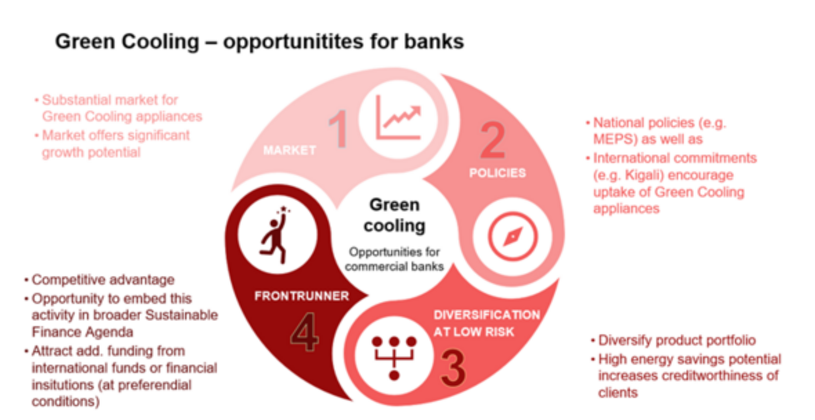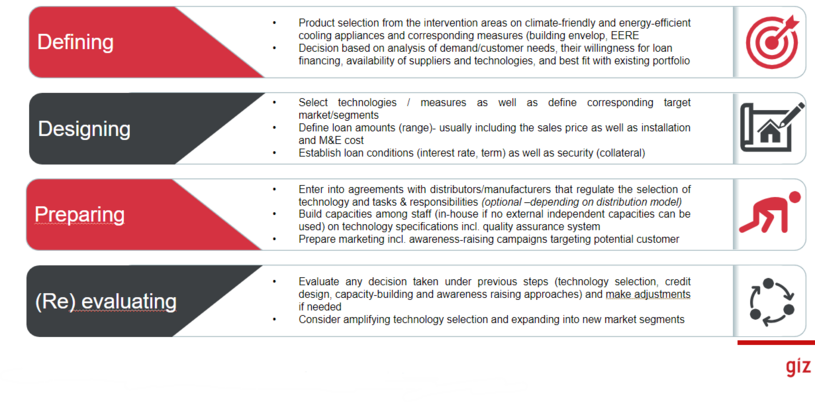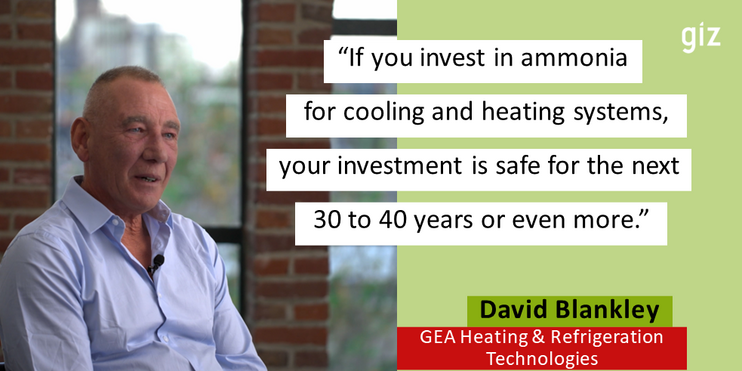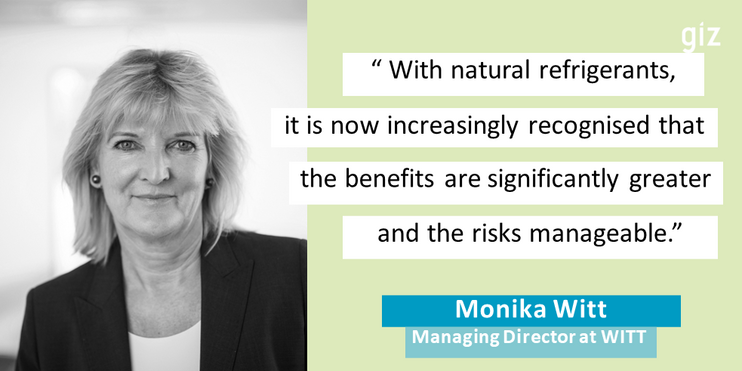Financing Green Cooling
The cooling sector accounts for over 10% of global greenhouse gas emissions. By 2050, the global cooling demand is set to triple (IEA 2018 (opens in a new window)), making cooling a key sector for combating climate change. Amidst this rapid expansion, transitioning to Green Cooling (opens in a new window) emerges as a compelling solution with substantial environmental and economic benefits.
However, the widespread adoption of Green Cooling faces hurdles, particularly in terms of affordability and accessibility. Overcoming these challenges demands strategic intervention. This is where financial institutions play a pivotal role: By offering tailored products such as green loans, they have the ability to not only facilitate the transition to a more sustainable and resilient future but also position themselves as drivers of positive change.
The business case for Green Cooling
The business case for Green Cooling
The benefits of Green Cooling technologies are compelling and multi-faceted. Foremost among its benefits is the potential to significantly save costs over the technology’s lifespan for end-users. Furthermore, switching directly to Green Cooling technologies eliminates the need for interim upgrades, resulting in long-term financial savings. While initial acquisition costs might appear higher, the substantial reduction in monthly energy expenses rapidly offsets this investment within a few years.
Beyond economic advantages, Green Cooling technologies offer a range of additional benefits. They do not operate with refrigerants which are harmful to the environment and cause considerably lower impact on global warming. Furthermore, their distribution fosters the creation of local jobs and industries.
Case studies provide tangible evidence of the economic viability of these technologies, showcasing successful implementation in various contexts. Materials for awareness-raising and educating customers are available for download below.
Discover best practice experiences of our Green Cooling network members!
Best-practice examples(opens in a new window) (opens in a new window)
Opportunities to financing Green Cooling Technologies

To understand the opportunities presented by Green Cooling financing, financial institutions should be aware of the specific benefits they may encounter in this dynamic landscape.
Benefits – exploring the green business case for financial institutions
Unlock a substantial and growing market: The demand for Green Cooling appliances is on the rise; occupying a new market niche
Alignment with national and international policies: Financing Green Cooling aligns with green finance, cooling, and energy efficiency programs on both national and international levels.
Future-proof business model and diversification of product portfolio: Financing Green Cooling can strengthen and diversify a financial institution's business model and portfolio of services and products.
Enhanced credit security: Energy savings resulting from Green Cooling can boost customers' financial capacity to repay loans.
Attract environmentally conscious clients: Offering green financing options can appeal to eco-conscious customers and businesses and enhance the reputation of its brand
Improved refinancing opportunities: Financial institutions have (partially preferential) access to selected credit lines and (international) funds.
Engagement with international stakeholders: Financing Green Cooling offers opportunities to collaborate with international stakeholders and donors.
Developing a Green Cooling loan product - a stepwise approach

The development of a credit product for Green Cooling technologies differs in many ways from the launch of conventional financial products. Firstly, it requires certain knowledge of technologies and distributers/manufacturers that may extend beyond the core expertise of financial institutions. Additionally, financing such technologies necessitates the involvement of other stakeholders, such as distributors/manufacturers or technical experts. Therefore, a structured approach is crucial in the development and launching of green credit products. The following steps should be considered, but must be adapted to local and context-specific conditions in each case.
Defining: Product selection for Green Cooling intervention areas, such as building envelope improvements and energy-efficient cooling appliances, is determined through analysis of customer needs, supplier availability, technology options, and alignment with the existing product portfolio.
Designing: This step involves selecting appropriate technologies and identifying target markets as well as determining loan amounts covering sales, installation, and monitoring & evaluation costs. Furthermore, loan conditions such as interest rates, term, and collateral requirements are established. Decision will be made on whether a new loan product will be launched or an existing product (e.g., a housing loan) will be amended.
Preparing: This involves forming agreements with distributors or manufacturers to govern technology selection and responsibilities (optional depending on distribution model), training in-house staff on technology specifications and energy efficiency, and creating advertising and awareness campaigns aimed at potential customers.
Re-evaluation: The final process includes reviewing and potentially adjusting decisions made in earlier steps, such as technology selection, credit design, capacity-building, and awareness campaigns, as well as exploring opportunities to expand technology selection and enter new market segments
Cooperation with distributors/ manufacturers
Green credit products share the commonality that they are predominantly used to finance certain technologies. These technologies are offered by manufacturers and distributors in the local market. In some cases, formalising collaboration between a financial institution and a manufacturer for a specific product makes sense, as it brings benefits to both parties. For instance, joint marketing efforts can be leveraged by both sides to reach new customers. However, such collaboration should be well-planned and regulated. To facilitate this, a Memorandum of Understanding (MoU) between the parties is recommended. An example MoU will be available to download here soon.
Green Cooling technologies - eligibility criteria
Due to the global phase-down of high-GWP fluorinated refrigerants like HFCs, the refrigeration and air-conditioning sector has to move to alternatives with lower GWP values, such as HFOs. This is a challenge. Alternatives comprise synthetic, fluorinated substances and natural refrigerants like hydrocarbons, carbon dioxide, and ammonia. Only natural refrigerants have no adverse environmental effects and therefore qualify for inclusion. Like the use of high GWP refrigerants, the use of natural refrigerants necessitates comprehensive training for RAC technicians, especially to ensure safe and efficient operation.
A whitelist offers concise technical guidance to bank officers for decision-making on Green Cooling solutions. It covers various applications like unitary air conditioning, chillers, heat pumps, residential, commercial, and industrial refrigeration, including transport and mobile air conditioning. The selection criteria focus on refrigerant and energy efficiency.
Prioritizing highly energy-efficient equipment not only benefits operators with lower operational costs but also contributes to grid systems and reduces greenhouse gas emissions. The whitelist advocates for new equipment to meet the highest energy efficiency standards, referencing model regulations from United for Efficiency for performance benchmarks and grading.
The whitelist will soon be available on this page.
Overview of (other) financial instruments for end-user financing
In addition to green credit products, there is a myriad of other innovative financial instruments that help overcome the barrier of the upfront investment. Each of these products has its unique use case, catering to specific group of customers. In the following, we provide a brief overview of potential financial products.
Pay-As-You-Go (PAYG) Mechanisms
Pay-As-You-Go (PAYG) mechanisms allow customers to pay for energy services in small, regular installments rather than a large upfront cost. This model is particularly useful for enabling access to energy-efficient technologies in cooling and refrigeration for customers who might otherwise be unable to afford them. PAYG systems often use smart meters to monitor usage and facilitate payments through mobile money or other digital platforms. Customers benefit from improved cash flow management and access to energy-efficient cooling without significant upfront investment. However, this model requires reliable payment systems and can result in higher overall costs due to financing and transaction fees.
On-Wage Financing
On-Wage Financing is a mechanism where employees finance energy-efficient appliances or systems, such as cooling and refrigeration units, through deductions from their salaries. Employers facilitate this financing by partnering with financial institutions or service providers, who offer the necessary equipment and services. The cost is gradually repaid over time through payroll deductions, making it easier for employees to manage the expense without a large upfront payment. This model can promote the adoption of energy-efficient technologies by making them more accessible to workers. On-Wage Financing helps employees spread out the cost of energy-efficient upgrades, ensuring they benefit from reduced energy consumption and lower utility bills. However, it requires robust administrative systems to manage payroll deductions and ensure repayments are aligned with employment terms, and it may be less flexible if the employee changes jobs.
On-Bill Financing
On-bill financing allows customers to pay for energy efficiency improvements through their utility bills, with the loan repayment offset by energy cost savings, ensuring the customer's monthly payment remains the same or lower. It includes two types: tariff-based, where the loan is tied to the energy meter and continues with new occupants, and on-bill repayment, where the loan is directly tied to the customer. This model provides flexible repayment options and cost-free efficiency upgrades for customers.
Cooling as a Service (CaaS)
Cooling as a Service (CaaS) is a model where customers pay for cooling services instead of purchasing and operating cooling equipment. CaaS providers install, maintain, and cover the energy costs of the cooling equipment, charging customers based on the refrigeration or cooling service provided. This shifts operational responsibility from the customer to the provider, who is incentivized to maximize energy efficiency for better earnings. CaaS eliminates customer concerns about equipment management and operation.
Energy Service Company (ESCO)
An Energy Service Company (ESCO) provides comprehensive energy solutions, including designing, implementing, and financing projects to improve energy efficiency and reduce operational costs. ESCOs often enter into performance-based contracts with customers, where the ESCO's payment is contingent upon the actual energy savings achieved. They handle all aspects of energy efficiency projects, from auditing to implementation and ongoing maintenance. In the context of cooling and refrigeration, ESCOs might upgrade or retrofit systems to enhance energy efficiency, covering the upfront costs and recouping them through shared savings. This model reduces financial and technical risks for customers, but it may involve complex contract negotiations and long-term commitments.
Energy Saving Agreement (ESA)
The Energy Saving Agreement (ESA) is a savings-as-a-service model where the ESA provider funds and manages energy-saving projects, paying the customer's energy bill and charging for the energy saved at a lower rate than the baseline utility costs. ESA providers have a strong incentive to optimize energy efficiency to generate savings. However, they face high upfront costs and performance risks, often resulting in higher fees for customers and potentially lower returns compared to other financing options.
Lease Financing
Lease financing involves a lessor owning the equipment and leasing it to a lessee, who pays regular lease fees. At the end of the lease term, the lessee can return the equipment, renew the lease, or purchase the equipment. This model offers simplified procedures, reduced investment risk, and access to the latest technology, but it also restricts equipment modification, imposes penalties for early termination, and can be more expensive than debt financing.
Further material
- What are the main sectors in which cooling is needed? What is the GHG-mitigation potential per sector? Find more information on our Green Cooling subsectors page.
How to qualify, certify and register the RAC workforce of the future? Find more information on our Fit for Green Cooling page.
Use our Country Data to find out more about global greenhouse gas emissions from the RAC sector.


